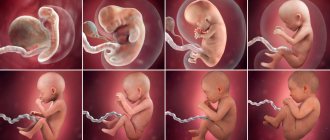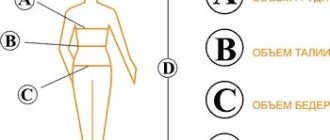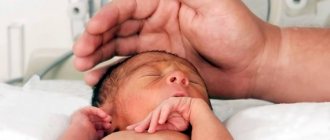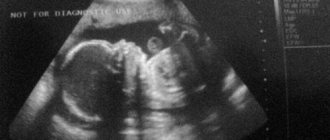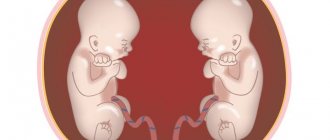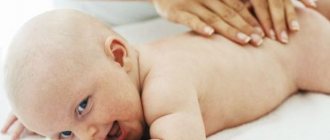Dear friends! I considered it necessary to clarify some concepts associated with small children, so I wrote the article “Newborn, baby, baby - why are babies called that? Newborn period" What words are not used in the language in relation to the smallest children: baby, child, doll, baby, child, infant, infant, crumb, infant, infant, child, bambino, baby. Maybe you will add something else to this list? Most of these words, of course, are colloquial, and many people use them as synonyms. Sometimes this is justified, sometimes it is acceptable, and in some cases... it makes you think. Let's take a closer look: what does “newborn baby” mean?
Child's infancy
If the baby is placed on a support, he will immediately straighten his torso and stand on bent legs.
This is the support reflex. If you slightly tilt his body forward, he will make stepping movements. This is called automatic gait. Place the baby on his stomach, he begins to crawl. If you place your palms on the soles of his feet, he will begin to push off to crawl faster. The third month can be turbulent for both baby and parents. Abdominal pain may occur, especially in artificial infants. The baby begins to actively smile, frown, and react to the interlocutor. Can turn and twist his head.
Until what age is a child considered an infant?
Currently, a baby is considered a child from 1 to 12 months - according to medical parameters (from birth to 1 month - a newborn). I specifically recently clarified this information at a children’s clinic (being the grandmother of a 12-month-old girl), since in my time it was a little different. Why this is so, I don’t know :-) PS If they talk about mother’s milk and the child’s independent refusal to breastfeed, don’t believe it :-) Nowadays this is not an indicator: unfortunately, many babies are bottle-fed almost from birth !
Breastfed means breastfed. It would seem that everything is simple and logical, but... Is it possible to call a child who is already three years old and still breastfeeding “breastfed”? I think no. And in general, everyone is fed differently - some for up to six months, others for several years.
Age periodization of childhood.
| Names of periods of childhood | Time, age | |
| Prenatal period of development (embryo, fetus, intrauterine child) | 28-30 weeks (premature babies) More than 42 weeks (post-term babies) | |
| Infancy (infancy) | Newborn period | 0-28 days (1 month) |
| Infancy | from 1 month to a year | |
| Early childhood (pre-school period) | from one year to 3 years | |
| Preschool age | Junior preschool | From 3 to 4 years |
| Secondary preschool | From 4 to 5 years | |
| Senior preschool | From 5 to 6-7 years | |
| Junior school age | From 6-7 years to 10-11 years | |
Up to what age is a child considered a newborn: baby’s age
The baby has been born, which means that the mother has a lot to meet, especially if this is her first child. When communicating with a pediatrician, when reading the literature, you may come across terminology - early neonatal, late neonatal periods. In addition, it becomes interesting to what age a child is considered a newborn, what is the age of a newborn and the infant period.
Until what age is a child considered a baby? There is an opinion that a baby is a breastfed child, but this is not true, because some are fed formula from birth, and some children continue to eat mother’s milk until they are 2-3 years old.
About feeding
A baby comes into this world unadapted to independent existence, so feeding an infant is an integral part of his life support. Parents are obliged to take care of him to provide all his physiological needs. Different types of feeding, depending on the existing capabilities and needs of the child, involve the use of breast milk, artificial formula and different types of complementary foods. Experts are confident that breastfeeding is optimal for babies.
Infant feeding should combine nutrients, fluids, and vitamins that are necessary for the body of a newborn baby. All these components are present in mother's breast milk.
Until what age is a child considered an infant?
Today we went to the hospital to donate blood. So the people in line all went crazy! It used to be like this: everyone came in every other time - before a year and after a year. And now they’ve come up with some crap that the so-called infants must enter separately!
We recommend that you read: Pension for Disabled Person of Group 2 2020
I also know that up to a year... and when we took the test at the clinic, and in the paid laboratory they always let us pass without a queue, at the clinic the people themselves told us to go through... and the doctors themselves called the paid one, so as not to worry about Lala
Infancy
- After six months, the child masters crawling, rolling over and can sit up independently;
- the crawling process is gradually transformed: “plastic” movement in 2-3 months develops into fast running on all fours;
- by 9 months, babies can stand up with support, and also move while standing, holding onto the sides of the crib or bed;
- by 11 months, the baby’s vestibular apparatus begins to function more or less normally, and now the child can stand independently, without holding on to anything, and even takes a few steps.
- By the age of one year, most children can already walk, although they do not do it quite confidently.
- The beginning of the infancy period begins after the newborn turns one month old, that is, the newborn stage immediately ends.
- The period of infancy ends when the baby turns one year old.
- Psychologists, neurologists and pediatricians divide infancy into several important stages. Some of the specialists divide this period almost equally, by half-years, others by quarters, that is, 3 months.
Infancy.
The newborn period is over, now from one month (more precisely, from the 28th day of life) until one year, the child will be called simply a baby. A newborn and an infant are combined under the term infant, infant. It would not be a mistake to consider the words “infant” and “baby” as synonyms, and newborns as the initial period of infancy. But with a baby, by the way, not everything is simple either. If today a child under one year of age is considered a baby, then back in the century before last, according to the dictionary of Vladimir Ivanovich Dahl, a child up to 7 years old was considered a baby!!! Here is the interpretation given by V. Dahl:
“...Infant m. child up to seven years old... Infancy, infancy cf. it is time and the age of a person is up to seven years ... "
V. Dahl also has the following interesting interpretations of the word CHILD:
“...the name of the children. until 14 or 16 years old, when childhood turns into adolescence...” I would say that this is no longer a CHILD, but a CHILD))).
I also learned from the Internet that the Church also considers a child under 7 years old to be a BABY. There are contradictions in the verbal definitions of some periods of childhood! Either we read from N.A. Nekrasov about a “little man” aged six, or we get acquainted with a similar interpretation of the word “baby”, which is completely inconsistent with modern ideas about this age!))) Most likely, these terms had not yet been worked out at that time time pedagogy and medicine. Let's finish this analysis of terms with a table of modern age periodization of childhood.
When do babies stop spitting up?
Any behavior that is characterized by anxiety and is not typical for the baby while eating should alert parents. It is better to consult a doctor who will help establish the process of normal feeding and digestion of food.
To understand whether everything is normal, you should know how often this process should take place. There are some cases where babies spit up every time they eat. This is due to errors during attachment or a hole in the nipple that is too large, as a result of which the baby swallows a lot of air.
Until what age is a child considered a newborn?
Once born, every baby will get to know many exciting things. Mom will undoubtedly have to learn new things too. In specialized literature you can often come across such a concept as a newborn baby. But many parents don't understand what it means. However, it is necessary to know this, because most recommendations are given directly in relation to newborn children.
The skin of most newborns has a yellowish tint. This is quite normal for a child's body. This phenomenon is explained by the massive breakdown of red blood cells (erythrocytes), which are accompanied by an increase in bilirubin in the blood. Normally, all this goes away without a trace two weeks after birth.
Reflexes of a child at the age of a newborn
A newborn already has enough signs thanks to which the baby adapts to his new living environment. In the scientific community, such signs are called reflexes. Healthy children have a developed respiratory, digestive, and circulatory system. The first reactions that appear in babies from the very first hours after birth are sucking and grasping (just give the baby your finger, he will immediately clasp it with his small hand). In addition, the newborn can protect itself, in particular its eyes. If a bright light hits him, he may close his eyes. At the same time, if you touch the middle of the baby's lip, he will turn his head in the direction where the light is coming from.
Several more reflexes are motor. Thanks to their study, it is possible to determine whether everything is in order with the tone of the newborn, as well as his motor ability. For example, if a child is placed on his tummy, he can turn his head to one side and crawl on his tummy without arms. If you support his feet with your hand, he will be able to push off from them, making crawling movements. You can also take the child in your arms so that the legs lightly touch a flat surface, and tilt the body a little forward - and then he will perform stepping movements.
All these signs or reflexes help doctors determine the child's level of development in the early stages. Their peculiarity is that they are characteristic only of the smallest and persist throughout the first months of life, and then fade away, giving way to other signs of the baby’s development. It is no longer reflexes that appear, but more complex reactions. Moreover, by the timing of the appearance and disappearance of certain reflexes and reactions, one can judge the intensity of the development of brain activity.
If the child is healthy and develops correctly, then he has the ability to feel some signs. For example, when touching something, he will feel whether the surface is hot or cold. The baby also feels pain and painful touches (that’s why he cries if he is given a vaccination injection). The child clearly distinguishes tastes. He knows where the sour, bitter, and where the sweet delicacy is. Naturally, a newly born baby has a low degree of sensitivity. But as it develops and grows, sensations develop and increase. The same applies to the vision and hearing of newborns - they develop as they grow. For example, already two weeks after birth, a crying baby can stop hysterics by listening to any strong sound. And after about a month, the baby’s eyes may focus on a bright or shiny object that will attract his attention.
Until what age is a child considered an infant?
In the first month, the baby smiles at his mother in response to her smile. By three to four months, surprise appears in response to surprise, anxiety and restlessness during discomfort. After four months, the child is friendly towards other acquaintances, but may be afraid of a stranger. If a stranger is friendly towards the baby, then soon the child begins to smile and rejoice at him. By eight months, the baby is afraid to be alone with strangers, especially if the first contact did not work out. At the same time, and up to eleven months, the baby is very worried about parting with his mother, while he cries and closes his eyes.
We recommend that you read: Changes to Military Mortgages in 2020
A one-year-old baby strives not only for active communication, but also for joint actions with adults. Adults treat the child as weak and helpless, but the baby does not think so and periodically rebels.
Physical development of the child
During the first 5 days of life, a newborn, as a rule, loses weight (the norm is about 5%), and after that it begins to recover and gradually gain as the child masters breastfeeding skills. On average, in the first 4 weeks, children gain about 500-700 grams of weight. This is one of the important indicators of the viability of a newborn human. In addition, his normal physical development is evidenced by an increase in height, head circumference and general health. There are other standards regarding the age at which a newborn should gain a certain weight. So, it is believed that by 4 months the child should double the weight that it had in the newborn state.
Today there is a trend of increasing weight of newborns. In many countries, the birth of children weighing over 4 kg has become typical. In addition, they are born with a height of more than 50 cm. This is one of the phenomena of acceleration.
The internal organs of the newborn are not yet fully formed. However, his digestive system begins to work actively, and the gastrointestinal tract is colonized by microorganisms. The baby's body temperature remains unstable for up to 3 weeks, so it must be maintained with the help of clothing and creating a certain comfort in the room.
At what age can you give honey to a child?
Despite the beneficial properties of this wonderful product, there is no consensus on whether to give it to children or not. Despite this, many parents still wonder at what age they can give honey to their child, considering it very useful.
To do this you need to perform a few simple manipulations. Apply a little honey to the skin of the hand between the index and thumb and rub lightly. Time it for at least 5 minutes. If during this time the skin has not changed, has not turned red, has not started to itch or hurt, and you do not observe an increase in body temperature, then your child does not have an allergic reaction to honey. You can safely treat your baby to a healthy product.
Infancy
The first month of life is very important for a child. After all, the development of the baby’s internal organs is not completed at the time of birth. Their improvement continues. For this reason, pediatricians pay special attention to babies during birth, carefully monitoring the development of the newborn.
The skin of most newborns has a yellowish tint. This is quite normal for a child's body. This phenomenon is explained by the massive breakdown of red blood cells (erythrocytes), which are accompanied by an increase in bilirubin in the blood. Normally, all this goes away without a trace two weeks after birth.
What age is a baby considered to be?
The fourth month is the time when active movements begin. The child tries to roll over in the crib, moves his arms a lot, smiles a lot and actively expresses dissatisfaction with facial expressions and crying. Speech perception gradually begins.
The baby also has innate reflexes. These are the support reflex, crawling and gait. Scientists have now found that if these reflexes are developed, the child will learn to crawl and walk at an earlier stage. This especially applies to children with disabilities of the musculoskeletal system. The sooner you start developing reflexes, the faster you can get rid of defects.
First year of life
When compared with other age periods, during the first 12 months the baby’s body grows rapidly, all systems and organs develop very quickly, and intensive metabolism occurs. For example, the weight of a baby with which he was born doubles by 4-5 months, and when the child reaches a year, it triples, amounting to approximately 10-11 kg.
During this period, the child’s height increases by a quarter of a meter, amounting to about 75 cm per year. The morphological structure and functions of the child’s nervous system are improved. In just the first 6 months of life, the mass of his small brain increases by 200%.
Due to the accelerated development of the functions of the central nervous system, the early development of conditioned reflexes of all analyzers occurs. Neuropsychic development occurs quite quickly. It is in the first year of life that babies begin to develop the rudiments of speech. When a baby is only 2 months old, all his senses are so developed that the child picks up and distinguishes different signals sent from the outside.
Baby what age
When familiarizing yourself with information on infants on the Internet, young parents often have a question: What is the very concept of “infancy of a child”? In the article below we will try to answer this question as fully as possible.
A baby who has just been born has very weak muscles. The newborn is not yet able to hold his head up and does not have the ability to focus attention on certain objects. In the first month of life, parents must constantly very carefully support the baby's head. During this period, parents are recommended to make eye contact with the baby as often as possible, which helps strengthen the emotional connection.
Oh, those teeth!
It is impossible to imagine a baby’s infancy without the appearance of teeth. This does not go smoothly for everyone. Children may have a fever, tearfulness and excessive salivation, and a decrease in appetite.
At about six months, the baby's first teeth appear - two lower incisors, and after a couple of months - two upper ones.
By 10 months, children have two upper lateral incisors, and by one year, two lower lateral incisors.
By the age of one year, toddlers usually already have eight baby teeth. If a child does not have that many teeth, parents should not worry: everything happens strictly individually. Some babies don't get their first teeth until they are one year old.
Do children's clinics need a baby day?
Of course, there are children's clinics where sick children , whom irresponsible mothers brought to the medical facility on Healthy Child Day, are looked after by pediatricians in special boxes , not allowing them to roam freely along the corridors. But in most cases, children with colds who have squeezed into the ranks of infants are simply not paid attention to .
We recommend that you read: Amount of Child Support in 2020
Baby Day is not a bad idea in itself: if you believe the information boards hanging around the clinic, it allows you to fearlessly bring your children for checkups and vaccinations, without fear of bumping into a sneezing teenager. But in practice, everything is far from so rosy.
In the hospital with a child up to what age
I'll try to explain. The fact is that people are in the hospital not only for treatment, but also for examination. So, for example, once a year my son goes to the hospital for correction of basic therapy. That is, during this period he does not have an exacerbation of the disease and is considered to be, in principle, healthy. Or, in general, an absolutely healthy child may be admitted to a hospital for a medical examination, for example, to a cadet military school. In such cases, it is believed that the child does not need special care and observation; accordingly, the mother does not need to be with him. You have a case where there are medical indications - he needs surgery. Therefore, there cannot be any ambiguous interpretation of this article, and the refusal to place you in a hospital with a child is illegal. In general, this is a judicial matter, and not just a disciplinary one, and they know it, so if you persistently let them know that you are aware, they will not refuse you. PS Lyuba, if you want, I can leave you an email address, you can write to me, I will answer your questions at any time. Just as a mother, I’m very worried about your child:))) Be healthy, don’t get sick!:)))
Please write, if your child was recently in the hospital, were you hospitalized with him? Write the child's age and city. My 6-year-old son went to the hospital on November 11, 2015, but they didn’t say whether they would let me in, they said it would be decided later.
* Embryonic and fetal periods of intrauterine development.
I must make a reservation that I included the intrauterine period of development in the table, although this is not entirely correct; it is not for nothing that during this period we talk about the child exclusively as the “future”.
But, at the same time, prenatal (antenatal) pedagogy is gaining strength in the world, in which the concept of “intrauterine child” has already fully found its place.
Prenatal pedagogy methods have confirmed their effectiveness, since their positive impact on the mental and physical development of children has been identified.
Realizing that we will have to touch upon this issue more than once, because science does not stand still, now I will only briefly dwell on some points.
- Everyone knows that a child is connected to his mother by an umbilical cord, through which he not only receives nutrition, but, for example, stress hormones and joy hormones also reach the fetus, exerting a certain influence on it. (read about hormones of joy on my other website in the section on a Healthy Lifestyle).
- Maternal emotions (joy, fear, worry) change the frequency of her heartbeat and the holding of her breath. And the future baby is also sensitive to these fluctuations. He may develop tachycardia, hypoxia, low weight, increased risk of death, asthma, etc.
- As is known, emotional stress of the mother can cause premature birth, developmental pathologies, decreased intelligence, tendency to develop bad habits in the future, etc.
I found figures on the Internet showing that mothers who took courses in prenatal education or psychology then gave birth to children
- whose memory was almost 50% higher than the average norm for children of this age;
- IQ was above average by almost 40%;
- social development is 50% higher;
- rational activity (practical intelligence) – by 80%!
These are the numbers!
But what can we say about the development of prenatal pedagogy in our country if elementary preschool education does not receive the due attention from the Education System.
Infant up to what age
The conclusion from this is this: doctors recommend feeding newborns in the first half of life only with mother’s milk, since during this period it exhibits the main nutritional and protective functions. Feeding with mother's milk in later stages is a personal matter for each individual family.
In the first month, the baby smiles at his mother in response to her smile. By three to four months, surprise appears in response to surprise, anxiety and restlessness during discomfort. After four months, the child is friendly towards other acquaintances, but may be afraid of a stranger. If a stranger is friendly towards the baby, then soon the child begins to smile and rejoice at him. By eight months, the baby is afraid to be alone with strangers, especially if the first contact did not work out. At the same time, and up to eleven months, the baby is very worried about parting with his mother, while he cries and closes his eyes.
A baby, but no longer a newborn
After the birth stage and after some time, the child moves from the newborn stage, when he was a completely helpless and incapable creature, into the infancy stage. During this period, the child seems to come to life, he becomes more active, his actions and gaze are more conscious, and all organs and systems of the body rapidly develop.
During this period, the child can already turn to an adult by looking, stopping at the parent’s face, or smiling. The older the child is, the more movements and actions are included in this communication. These are sighs, movements of arms and legs, exclamations of delight, cries of joy. If a child wants communication, but there is no one nearby or no one pays attention to him, he may cry and thereby turn all eyes on himself. All these actions appear at certain stages of the baby’s development. And control of their timely appearance is the key to the correct development of the child, his brain activity and nervous system.
A distinctive feature of a child's revival is his activity. The less attention adults pay to the baby, the more actively he shows his need for communication. It is through movements, glances, and emotions that a deep and strong connection between the baby and his parents is established, which will only grow stronger over the years.
